
The International Day of Yoga this year is on June 21st— the first day of Summer. I can’t think of a better day to get outside and do some yoga.
You can practice anywhere, but it’s nice to have your own yoga sanctuary. Mine is in my home in my living room. It’s bright and airy, and it feels like I’m in nature. I also like to light a soy candle and burn some sage before I start to really prepare the space for my daily practice. No matter where or when you practice though, yoga is a beautiful and restorative way to help you feel balanced and more present.
Yoga is also deeply connected to the Four Cornerstones of True Beauty— and through practicing yoga, you can own your true beauty and feel good, inside and out.
The Four Cornerstones of True Beauty are a philosophy that recognizes the importance of a more holistic approach to health and wellness. True beauty isn’t just what’s visible on the outside— it exists within you as well. It’s a kind of beauty that yoga guru Yogananda calls “beauty of the soul.”
But if you want to reach your highest level of beauty, power, energy and vitality, you need to take care of yourself in a more holistic way.
The Four Cornerstones of True Beauty are Food, Body, Emotional Well-being and Spiritual Growth. It’s important to nurture all four cornerstones for total health and wellness. If you ignore any of these cornerstones, you begin to obsess over the others. But through the power of yoga, you can take this holistic journey with me and learn to connect and get in touch with your whole self.
So before we all roll out our yoga mats, let’s examine the amazing health benefits of yoga according to the Four Cornerstones of True Beauty. You might be surprised at how yoga impacts every aspect of your being!
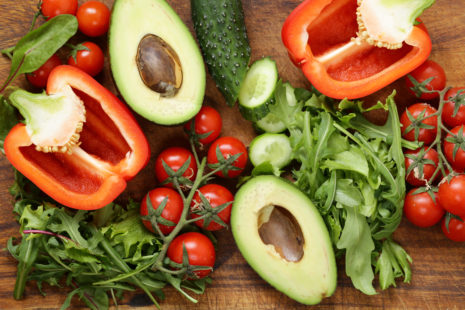
Cornerstone #1: Food
Yoga and food are more closely related than you may expect! The foods you eat are vital to a healthy yoga practice, but yoga can help you make better food choices and eat more intuitively. The food you eat is so important to your overall well-being. That’s because your food choices can either nourish you or make you sick.
I’ve written an article about how yoga nutrition can take your practice to the next level, where I talk about how you aren’t what you eat— like the old saying says— but you are what you digest and assimilate.
When you eat a wholesome and balanced diet, you feel more energized, healthier, and more beautiful. When you eat a diet full of processed foods, excess fat and sugar, you feel run-down, bloated, and just… awful. When you combine a healthy diet with a regular yoga practice, you can begin to heal your body and your mind on a profound level.
To get the most out of your yoga practice, you want to make sure to eat plenty of sattvic foods, which help keep you calm and happy. These include:
- Fresh fruits and vegetables
- Whole grains
- Nuts, seeds and legumes
- Herbal tea
On the other hand, you should avoid tamasic foods that can drain your energy. Some of these include:
- Processed food
- Alcohol
- Rotten or unripe foods
Yoga helps you become more mindful, and that extends to what you choose to put into your body. So yoga helps you listen to your body and become more attuned to your body’s needs, including what nutrients your body needs to be at its most vibrant and healthy.
Yoga also promotes digestion by exercising and massaging your internal organs. That gentle stimulation helps give your digestive system a little extra oomph when it comes to digesting your food and eliminating waste from your body.
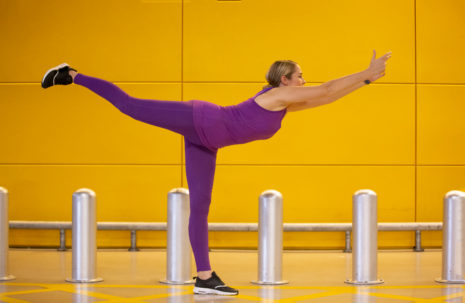
Cornerstone #2: Body
This is probably why many people start exploring yoga! And for good reason too— yoga asanas, or yoga poses, are great exercise!
The physical activity of yoga gently stretches and exercises your whole body without making you feel tired or sore. That’s because unlike most exercise regimens, the adage “no pain, no gain” does not apply to yoga!
It’s meant to help you develop slowly and gently. In fact, you may not even realize you’re making progress until you discover how different you look and feel!
However Beauty, the asanas or yoga poses aren’t what yoga is all about. But if the physical aspect of yoga is what inspired you to get started, there’s nothing wrong with that. :)
3 Amazing and Relaxing Yoga Asanas for All Skill Levels
Looking for some amazing poses to help you reach that sense of zen? These 3 yoga asanas will help you move your body, reduce stress and relax whether you are an absolute beginner or an experienced yogi.
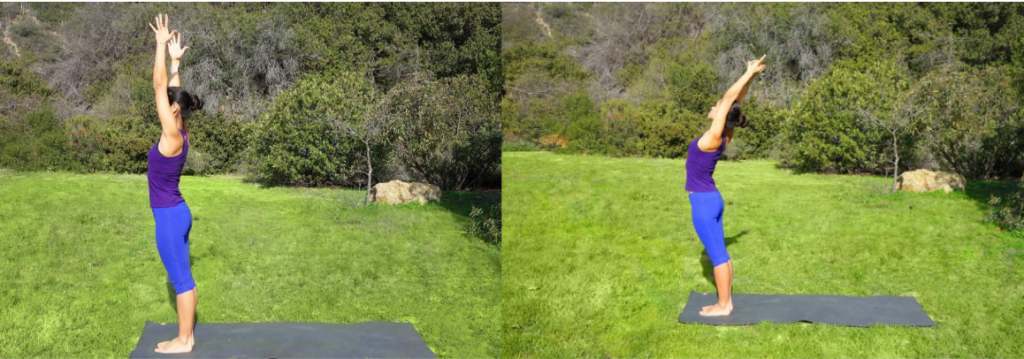
Upward Salute
Upward salute is so simple but so beneficial to your body and your mind. This simple pose stretches your belly, arms and shoulders. It also improves your digestion, posture, and can help calm your mind if you’re feeling anxious.
Here’s how to do it:
- Stand with your feet together, arms at your sides. Root down through your heels, straightening your legs.
- Engage your quads while rotating them inward. Widen your sitz bones.
- Broaden across your chest and collarbone. Lengthen your neck, and release your shoulders away from your head.
- Lift your arms out to the side and then overhead as you inhale. Your palms should be facing each other, fingers reaching toward the sky.
- Gently relax your shoulders by dropping the top of each shoulder down away from your ears.
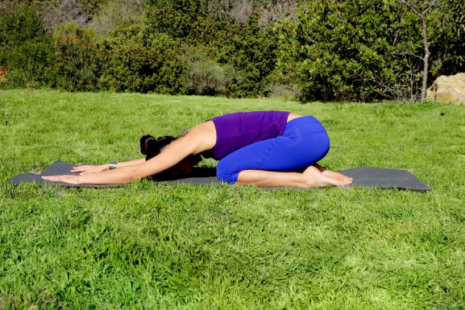
Child’s Pose
Child’s pose is a deeply restorative pose, and is an excellent way to rest after a challenging asana, or even after a period of stress. This pose also stretches your body from your back to your ankles.
Here’s how to enter child’s pose:
- Begin in a kneeling position, and take a deep breath.
- As you exhale, lower your glutes towards your heels.
- Bend down toward the floor, rolling your torso over your thighs, lengthening the back of your neck before your forehead rests on the floor.
- Lay your arms by your thighs with palms facing up. You can also stretch your arms in front of you near your ears.

Mountain Pose
Many poses— including warrior pose and all its variations— begin with mountain pose. It’s a basic and simple standing pose and is a starting point for other standing postures in yoga. It strengthens legs, improves your posture and firms your abs and your glutes.
Here’s how to enter mountain pose:
- Stand straight with your feet parallel, your big toes together. Your heels should be a little apart and your middle toes pointing forward.
- Ground your energy evenly through your feet, and gently pull up from your spine. Your chin should also be parallel to the floor.
- Open your chest and shoulders slightly, without moving them forward.
- Bring your hands together with palms pressing, or let your arms drop gently to your sides.
The Health Benefits of Yoga Asanas
While yoga asanas are great exercise, there’s more to them than that. The gentle movements are designed to help you experience positive shifts in your body, even in areas that can’t be seen by the human eye. This can include:
- Strengthening and lubricating your joints— including “problem” areas like your knees, hips and ankles. It may even strengthen joints you don’t use regularly!
- Reducing joint pain and relieving chronic pain like arthritis, lower back pain and fibromyalgia. [1]
- Increasing strength and flexibility— especially in your spine. A healthy and flexible spine is so important to your vitality and feeling young for years to come.
- Improving posture.
- Helping you move with more grace and ease— maybe even more than you’ve had in years.
- Promoting beauty by helping your body rid itself of toxins that can dull your skin and your hair.
- Increasing blood flow to all parts of your body.
- Improving your immunity, and can protect you against serious health disorders like heart disease and high blood pressure.
But yoga isn’t just amazing for making your body look and feel good. It does absolutely beautiful things with your mind as well!
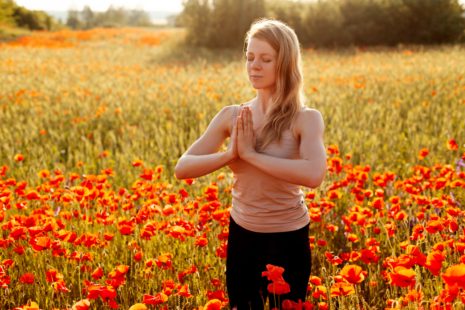
Cornerstone #3: Emotional Well-Being
Yoga and meditation go hand-in-hand. That’s because they’re both amazing for stress management and nurturing your emotional well-being and mental health.
But yoga isn’t just about the poses. Yoga is meant to balance your mind and support your personal growth and evolution.
It’s easy to focus entirely on the poses because that’s what is most visible with yoga, but every part of yoga from the poses to the breathing to the mindfulness they’re all connected. And when you fully connect with each aspect, that’s when your yoga practice transforms and you take it to the next level.
Practicing yoga can help you become more present, and help you deal with life one step at a time. In our perfectly imperfect lives, I think that’s such a valuable skill to have.
You can practice yoga at home or outside of it— as long as you create the time and space you need for it, even if it is just 10 minutes a day, 3-5 times a week at home.
In fact, I love practicing yoga at home because there are no rules. You’re creating your own practice in your own place. You can really listen to your body and practice what you need, when you need it.
Through rejuvenating physical postures like child’s pose and corpse pose, yoga reduces the amount of cortisol— the stress hormone— in your body so you can truly de-stress. And it’s not just the poses themselves that help you foster emotional well-being. The cleansing deep breathing is absolutely vital too.
By controlling your breathing, you can control your body and quiet your mind. That’s the key to stress reduction and building your inner strength. These yoga postures and breathing techniques help calm your nervous system, relieve stress, and boost your mood. [2]
And when you’re calm, cool, and collected you may notice a wonderful shift in yourself. You may feel more resilient and more balanced inside, and more able to roll with the punches, so to speak. :)
Not only that, but the healthy emotional well-being yoga can help you achieve can also transform how you interact with others. By feeling great emotionally, you may find that people are more drawn to your natural magnetism!
Interested in learning more about meditation? Check out my 7 guided practical enlightenment meditations! This series pairs each movement with a mantra so that you can relax your body, calm your mind and form a deeper connection with your true self.

Cornerstone #4: Spiritual Growth
When you hear the word “spiritual,” you probably think about religion. But you don’t have to be religious to have a spiritual side, or to want spiritual growth. That’s another beautiful thing about yoga.
The rich philosophy of yoga helps you connect with your spirit and become attuned to your personal needs. It can help you see things more clearly and become more grounded. You may even feel yourself become more loving and more compassionate. You reach greater levels of awareness and clarity. You feel more at peace with yourself, and more joy in your life.
When you connect with yourself, all other aspects of your life benefit from this spiritual growth.
How I Discovered Yoga (And My Spiritual Side)
I discovered yoga in the deeper sense— not just through the shapes of physical asanas— after learning about Paramahansa Yogananda. It’s funny because while he brought yoga to the western world in the early part of the last century, I didn’t discover him until I was in India.
When I found Paramahansa Yogananda in India, that’s when and how I learned the meditation practices that I still incorporate in my life to this day.
I think it’s important to learn about yoga teachers and gurus so you can get an expanded sense of where one’s yogic teachings and lineage are derived from. It is my honor to offer you some information on Paramahansa Yogananda, who is my personal guru and whose meditation techniques and philosophy are intertwined throughout all that I do, including my yoga practices.
In my latest book, You Are More Than You Think You Are, I dive deeply into sharing more about my guru, his lasting impact on the world and myself.
The Beauty Detox dietary philosophy, my writing, my work, my relationships and well, pretty much everything, has been influenced by Yogananda’s teachings.
They have given me incalculable gifts, including personal peace, understanding and focus. I would not feel right writing this without sharing the most important part of my personal practice with you.
My Personal Meditation Practice
I try to incorporate 30 minutes of meditation into each morning and night, and longer on the weekends and when I can. That may seem like a lot of time to spend sitting still, but it makes everything else in my life go much more smoothly.
That time spent sitting ensures that I’ll be much more present and focused during the hours I spend working, or just hanging out with friends and family.
And the more you get into meditation, it is true that more joy pours out of you from within! I now crave my meditation time. But it did not start out so easy to meditate for this long.
I used to get antsy after 5 or 10 minutes, which you may also experience. That is natural, but over time, like any practice, you will experience improvement and it will become easier.
It did for me. :)
Who is Paramahansa Yogananda?
Paramahansa Yogananda is widely recognized as the one that first brought yoga to the West. He founded the Self-Realization Fellowship in 1920 to make available the universal teachings of Kriya Yoga, a sacred spiritual science originating thousands of years ago in India. Yogananda initiated thousands into the Kriya Yoga path, including Mahatma Gandhi.
Yogananda believed in unity between Eastern and Western beliefs. His meditation techniques are applicable to all, regardless of one’s background, religion, or lack thereof.
These nonsectarian teachings embody a complete philosophy and way of life for achieving complete success and well-being. These teachings also include meditation techniques for achieving oneness, joy, and inner peace.
The Philosophy of Kriya Yoga
Paramahansa Yogananda’s goal was to show that the different religions and yoga could exist in harmony. And Kriya Yoga isn’t just about the physical asanas that you may associate with yoga— and that we are going to be practicing in our flow sequences— though they are a major component.
The core is a sequence of scientific meditation techniques with the main goal of helping people realize themselves and begin to look at the world in a whole new way. The essence of Yogananda’s teachings is to show all how to really connect with the divine within themselves. To experience the joy, wisdom, and creativity we all have inside of us— and how to view the outside world from that perspective.
Kriya Yoga meditations are authentic and systematic, and I highly recommend them to everyone. It’s actually one of the first things I suggest for healing yourself from within.
For more information about the Kriya Yoga path of meditation, I recommend checking out the Self-Realization Fellowship site. Here you can apply to take their home-study lessons, which get mailed to you every two weeks.
Through these lessons, you will not only learn the meditation techniques, but also lessons on all aspects of life— like how to get along with others as well as yourself, how to increase focus and concentration, how to conduct yourself in your business and family life, and so on.
True Beauty is Not Just Skin Deep
Yoga can truly benefit all aspects of your life. Beauty, I was in awe of how much my day-to-day life changed when I started my yoga practice. I not only felt more in tune with myself, but I felt more magnetic and connected in my relationships with others too.
Yoga can make you more mindful of what you eat, it can protect your heart health and your overall health, make you look good, and make you feel good. And when you think about it in relation to the Four Cornerstones of True Beauty, yoga helps you own your true beauty, outside and in.
Looking for a great yoga class for International Yoga Day? Try my Beauty Detox Power Yoga series! Whether you’re a beginner, intermediate or advanced yogi, this home yoga course will help you understand the yoga philosophy, as well as reap the physical, emotional and mental rewards of a yoga practice.
So are you excited to break your yoga mat out yet, Beauty? I am! :)
In love and encouragement,

Citations
- “Yoga for Pain Relief.” Harvard Health, 29 Apr. 2015, www.health.harvard.edu/alternative-and-integrative-health/yoga-for-pain-relief.
- “Yoga: Fight Stress and Find Serenity.” Mayo Clinic, Mayo Foundation for Medical Education and Research, 29 Dec. 2020, www.mayoclinic.org/healthy-lifestyle/stress-management/in-depth/yoga/art-20044733.
The post The Benefits of Yoga According to the Four Cornerstones of True Beauty appeared first on Solluna by Kimberly Snyder.
No comments:
Post a Comment